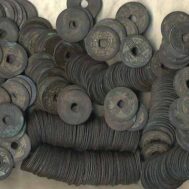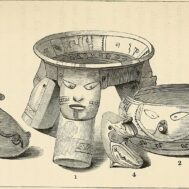Art Friedberg grew up as part of perhaps the only family coin business operated out of major department stores. During college at George Washington University, he started working at his family’s concession at Woodward and Lothrop in downtown Washington, DC. The operation sold a wide variety of US, foreign, and ancient coins as well as common ancient oil lamps and coins supplies not only at “Woodies” in Washington, DC, but through franchises at other major department stores around the country.
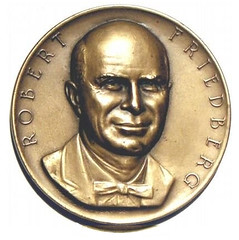
Arthur Friedberg, medal struck in his honor by the Coin and Currency Institute as a tribute to Friedberg after his death in 1963.
It all started with Art’s dad, Robert. Robert’s story is a bit unusual, but it broadly followed the trajectory of other self-starting American entrepreneurs of the early 20th century. Robert was born in Atlantic City, New Jersey, in 1912 to a family of Russian/Polish-Jewish immigrants. As a kid, he acquired his first foreign coins from sailors who visited his father’s tailor shop located near the Harborside Terminal on the New Jersey side of the Hudson River. While at college in New York City, he founded Capitol Coin Company, a mail order coin business, with his 16-year old brother, Jack. During World War II, he served in the US Army in Europe, where he was able to acquire more inventory for his growing business.
So how did coins join glassware, furniture, home appliances, clothing and shoes on department store shelves? Simply, selling coins was treated as selling other consumer goods, albeit as a specialized product that required the expertise of numismatists rather than typical department store employees. But it all only became a reality through Robert’s business relationship with a well-known stamp dealer, Jacques Minkus, probably one of the first to bring collectibles, in the form of stamps, to department store counters.
Minkus was quite the promoter. Back in 1931, he had convinced Bernard Gimbel to allow him to open a small counter at the back of his flagship store at 33rd and Broadway to sell stamps. By the 1940s, Jacques had taken over much of the ground floor, and had expanded the operation to other department stores around the country.
Soon, Minkus decided to expand this empire further by promoting another popular collectible, coins. So, in 1947, he entered into a business relationship with Robert, who by that time had built up his own business. After a trial period, Robert ultimately agreed to pay Gimbels 20% gross on sales for use of its retail space, and also helped with the expansion to other stores. That business relationship took off with an expansion to 38 other department stores around the country.
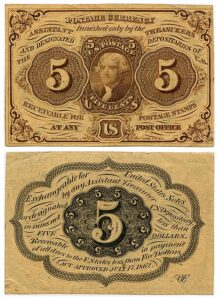
Five-cent US Postal Currency, first issue, featuring Thomas Jefferson. Gold, On July 17, 1862, Congress authorized printing of Postal Currency notes in the denominations of 5, 10, 25 and 50 cents.
Destiny also decreed that Capitol Coin would become a true family business as Robert also found love among collectibles. Soon after starting, he began a relationship with Minkus’ assistant, Goldye Nessanbaum. Robert and Goldye got married in 1948, and soon had two sons, Ira and Art , who also ultimately joined the business along with Robert’s brother, Jack.
Somehow Robert also found time to write and publish In addition to Capitol Coin Company, he formed the Coin and Currency Institute to publish books and sell coin supplies. His groundbreaking Gold Coins of the World was first published in 1958 and has been updated periodically since. Other books, including an important series on paper money, followed.
Robert knew relationships with other dealers were important to his own acceptance and success. As a result, Robert’s firms became founding members of both the International Association of Professional Numismatists and the Professional Numismatists Guild. Art subsequently became the IAPN’s President from 2001-2007.
Robert also knew that the key to the success of any franchise operation is a proper degree of control. For the franchise formula to work, coins purchased over the counter at stores nationwide were first sent to New York to be resorted before being distributed to other stores as needed. Capitol Coin Company also published price lists that could be overprinted with the name of the franchise stores. On occasion, rarities like the circulated 1894-S dime showed up for purchase over the counter. Such high priced coins tended to be resold outside normal channels because the typical department store buyer only purchased coins from $1 to $100 in value.
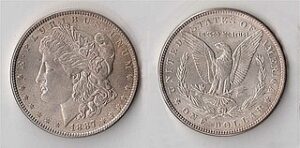
1887 Morgan Silver Dollar, Photo by Albertomos, public domain.
Sadly, Robert passed away far too early from cancer in 1963 at the age of 50, leaving the business in the hands of his wife Goldye, his brother Jack, and ultimately his two sons, Ira and Art. They continued selling coins in department stores for some years, but by the 1970s demographic changes and the resulting decline of the economic fortunes of inner cities started to take their toll on the business.
Art tells one story that sums it all up. While coin sales started to languish during this period, sales of “coin bags” took off at Woodies in DC to an entirely new clientele. The local cops were called for advice, but they counseled the business to just keep on selling the “coin bags.” After all, clean containers for “consumables” were just as important as for “collectibles.”
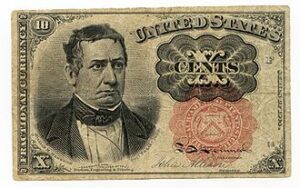
Front side of an 1874 U.S. Currency Fractional 10 Cent Note, showing William M Meredith, Secretary of the Treasury.
Ultimately, economics caught up with the department store franchise operation and the all the concessions ultimately closed. Nonetheless, Coin and Currency institute has lived on publishing books and acting as a sales agent for world mints. Recently, Coin and Currency Institute sold its book catalogue to Whitman Publishing. As for Capitol Coin, it continues to operate a store in DC, but for years it has been mainly focused on the collectible DC does best, political memorabilia. For more, see Careful Collector No. 31 – It’s the Political Season So Why Not Collect Political Memorabilia?
Careful Collector would like to thank Arthur Friedberg for sharing his reminiscences about his family’s business.
This installment marks the last of the Careful Collector series. It has been an interesting journey. Whatever you do, be careful, but keep on collecting!
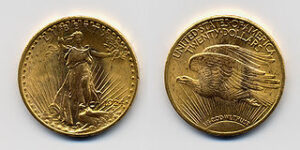
1924 USA St. Gaudens, 20 dollar gold coin.
For More Information:
On the Freidberg Family’s Capitol Coin Company and Coin and Currency Institute
Coin and Currency Institute Website, available at https://www.coin-currency.com/index.html (last visited March 13, 2025).
Careful Collector No. 31 – It’s the Political Season So Why Not Collect Political Memorabilia? Cultural Property News (September 310, 2024), available at https://culturalpropertynews.org/careful-collector-no-31-its-the-political-season-so-why-not-collect-political-memorabilia/ (last visited March 15, 2025).
Robert Friedberg (1912-1963), E-Sylum (1/2/2022), available at https://www.coinbooks.org/v25/esylum_v25n01a16.html (last visited March 13, 2025).
Reader Comments on the Woodward & Lothrop Store Coin Department, E-Sylum (6/5/2011), available on the Newman Numismatic Poral at the Washington University of Saint Louis, https://nnp.wustl.edu/Library/Periodical/13332 (last visited March 13, 2025).
On Jacques Minkus
Jacques Minkus (1901-1994), American Stamp Dealers Association Website (undated), available at https://www.americanstampdealer.com/SubMenu/Jacques_Minkus.aspx (last visited March 13, 2025).
On Department Stores
A History of the Department Store, BBC Culture (undated), available at https://www.bbc.com/culture/bespoke/story/20150326-a-history-of-the-department-store/index.html (last visited March 13, 2025).
Department Stores, Wikipedia (undated), available at https://en.wikipedia.org/wiki/Department_store (last visited March 13, 2025).
[1] Peter K. Tompa is a semi-retired lawyer who resides in Washington, D.C. He has written extensively about cultural heritage issues, particularly those of interest to the numismatic trade. Peter contributed to Who Owns the Past?” (K. Fitz Gibbon, ed. Rutgers 2005). He formerly served as Executive Director of the Global Heritage Alliance and now is a member of its Board of Directors. (https://global-heritage.org/) He currently serves as the Executive Director of the International Association of Professional Numismatists. (https://www.iapn-coins.org/ ) This article is a public resource for general information and opinion about cultural property issues and is not intended to be a source for legal advice. Any factual patterns discussed may or may not be inspired by real people and events. The opinions stated in this article are the author’s alone and should not be attributed to any affiliated organization.
 Midtown New York traffic under Gimbel's Bridge, Photo by joiseyshowaa from Freehold, NJ, USA, 29 January 2010, CC by SA 2.0.
Midtown New York traffic under Gimbel's Bridge, Photo by joiseyshowaa from Freehold, NJ, USA, 29 January 2010, CC by SA 2.0. 